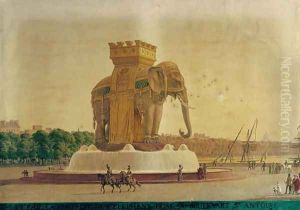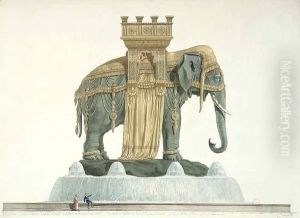Jean Antoine Alavoine Paintings
Jean Antoine Alavoine was a French architect known for his neoclassical style and significant contributions to Parisian architecture during the late 18th and early 19th centuries. Born on February 7, 1778, in Paris, France, Alavoine grew up during a period of great change, encompassing the French Revolution and the Napoleonic Wars. These events influenced the culture and architecture of the time, as new ideas and aesthetic values began to permeate French society.
Alavoine was admitted to the École des Beaux-Arts in Paris, where he studied under architects such as Charles Percier and Pierre François Léonard Fontaine, who were proponents of the neoclassical style that sought to revive the principles of classical Greek and Roman architecture. This education set the foundation for Alavoine's architectural approach, which he would carry into his professional career.
Throughout his career, Alavoine was involved in several important projects. One of his most notable works was the completion of the Colonne de Juillet, a monumental column situated in the Place de la Bastille in Paris, which commemorates the events of the July Revolution of 1830. Although the column was originally conceived by another architect, Alavoine played a key role in its completion after the previous architect's death.
Alavoine's other significant works include the design and construction of the Church of Saint-Philippe-du-Roule in Paris, which showcased his mastery of the neoclassical style with its Corinthian portico and well-proportioned façade. He also contributed to the restoration and modification of several historic buildings in Paris, including the Church of Saint-Germain-des-Prés.
Despite his success, Alavoine's career was not without challenges. The political and social turmoil of the time, including the restoration of the Bourbon monarchy and the subsequent changes in government, affected the commissioning and funding of architectural projects. Nonetheless, Alavoine's work remained influential, and his architectural legacy can still be seen in the urban fabric of Paris today.
Jean Antoine Alavoine passed away on December 11, 1834, in Paris. His death marked the loss of a key figure in the neoclassical movement in French architecture. His vision and execution left a lasting impact on the Parisian landscape, and his works continue to be studied and admired for their elegance and historical significance.

